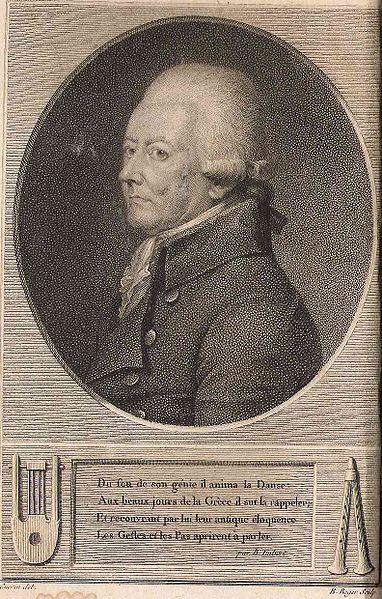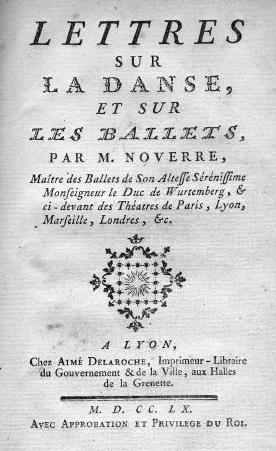<Back to Index>
- Philosopher Ernst Maria Johann Karl von Feuchtersleben, 1806
- Balletmaster Jean Georges Noverre, 1727
- Empress of Ethiopia Zewditu I, 1876
PAGE SPONSOR


Jean-Georges Noverre (29 April 1727 – 19 October 1810) was a French dancer and balletmaster, and is generally considered the creator of ballet d'action, a precursor of the narrative ballets of the 19th century. His birthday is now observed as International Dance Day.
His first professional appearances occurred as a youth in Paris at the Opéra-Comique, at Fontainebleau, in Berlin before Frederick II and his brother Prince Henry of Prussia, in Dresden and Strasburg. He moved to Strasbourg where he remained until 1750 before moving to Lyon. In 1751, he composed his first great work, Les Fêtes Chinoises for Marseilles. The work was revived in Paris in 1754 to great acclaim. In 1755, he was invited by Garrick to London, where he remained for two years. Between 1758 and 1760 he produced several ballets at Lyon, and published his Lettres sur la danse et les ballets.
It is from this period that the revolution in the art of the ballet for
which Noverre was responsible can be dated. He was next engaged by Duke Karl Eugen of Württemberg, and later Austrian Empress Maria Theresa, until 1774. In 1775, he was appointed maître des ballets of the Paris Opera at the request of Queen Marie Antoinette.
He returned to Vienna in Spring of 1776 to stage ballets there but in
June 1776 he returned again to Paris. He regained this post until the French Revolution reduced him to poverty. He died on October 19, 1810, at Saint-Germain-en-Laye. Noverre's friends included Voltaire, Mozart, Frederick the Great and David Garrick (who called him "the Shakespeare of the dance"). The ballets of which he was most proud were his La Toilette de Venus, Les Jalousies du sérail, La dour corsaire and Le Jaloux sans rival. Besides the letters, Noverre wrote Observations sur la construction d'une nouvelle salle de l'Opéra (1781); Lettres sur Garrick écrites a Voltaire (1801); and Lettre à un artiste sur les flies publiques (1801). Noverre
was born in Paris on 29 April 1727 to Marie Anne de la Grange and
Jean Louys, a Swiss soldier. The couple expected their son to pursue a
military career but the boy chose dance, studying with M. Marcel and
then with the famous Louis Dupré. Noverre's first professional experience probably occurred at the Opéra-Comique in Paris on 8 June 1743 in Le Coq du village. In his middle and late teenage years, Noverre performed at Fontainebleau, and in Berline before Frederick II and his brother Prince Henry of Prussia. Appearances in Dresden and Strasbourg followed before his return to the Opéra - Comique. In 1747, Noverre became ballet master in Marseilles and created his first great success, the exotic Les Fêtes Chinoises. He is believed to have married the actress Marie - Louise Sauveur while
employed in Marseilles. In 1750, he became principal dancer in Lyon and created his first ballet - pantomime, Le Jugement de Paris. He moved to Strasbourg for one year in 1754, and returned to the Opéra - Comique where Les Fêtes was staged with great success on 1 July 1754. In 1755, he went to London with his wife, his sister and brother, and his company. There, he worked with David Garrick of the Drury Lane Theatre, learning new concepts of theatre and the then developing natural style of performance. When the London production of Les Fêtes was completely destroyed by rioters on the eve of the Seven Years War,
Noverre and his family were forced to go into hiding. He continued to
supervise dance spectacles at Drury Lane but without billing. He left
London in 1757 wanting to work at the Paris Opéra but realized
he would face serious opposition to the expressive style he had
developed in London, and chose Lyon instead where he was free to
develop new and very different works from the prevailing court ballets.
He composed Les Caprices de Galathée,
for example, and garbed his dancers in tiger skins and shoes made of
tree bark. His naturalist attitude towards costume placed him in the
front rank of the French Enlightenment.
Noverre's
treatise on dancing and theater expressed his aesthetic theories on the
production of ballets and his method of teaching ballet. Noverre wrote
this text in London in 1756 and published it in 1760 in Lyon, France.
He began his research for his essays in Drury Lane, London where he
choreographed for his own troupe of dancers at the Theater Royal under
the direction of David Garrick. It was in David Garrick’s library that
Noverre read modern French literature and ancient Latin treatises on
pantomime. Noverre was inspired by the pantomimes that he thought
stirred up the audience's emotions by the use of expressive movement.
He proclaimed in his text that ballet should unfold through dramatic
movement and the movement should express the relationship between the
characters. Noverre named this type of ballet, ballet d’action or pantomime ballet and produced his first serious pantomime ballet, called Le Jugement de Paris, in 1751 in Marseilles.
Noverre was most immediately influenced by Jean-Philippe Rameau, Marie Sallé and David Garrick.
Rameau was a very influential French composer and music theorist and
Noverre was inspired by his dance music that combined programmatic and
strongly individual elements. Marie Salle and Noverre were both dance
students at the Paris Opera Ballet and met early on in their careers.
Marie Salle, a Romantic ballerina with expressive qualities, likely
influenced Noverre to write about the importance of expression in
dance. David Garrick was an actor and theater director at the Theater
Royal. Noverre was inspired by his talent for "histrionics". Noverre's
text demanded an end to repressive traditions peculiar to the Paris
Opera Ballet, such as stereotypical and cumbersome costumes, and
old-fashioned musical styles and choreography. Noverre also discussed
the methods for training dancers such as encouraging a student to
capitalize on his or her own talents. Most of Noverre's criticisms of
dance in his book were
directed towards the Paris Opera Ballet because
he felt the Paris Opera Ballet created ballets that were an isolated
event within Opera lacking meaningful connection with the main theme of
the Opera. He criticized the Paris Opera Ballet' use
of the mask because it restricted the dancer from showing facial
expressions that could bear meaning on their characters. Noverre
devoted the whole of his Ninth Letter to the subject of masks and
wrote, " Destroy the masks and" he argued, "we shall gain a soul, and
be the best dancers in the world." Noverre specifically dealt with
seven major points in his treatise:
Noverre's
Les Lettres Sur La Danse et Sur Les Ballet had lasting impact on ballet
ideology as his text has been printed in almost every European Language
and his name is one the most frequently quoted in the literature of
dance. Many of his theories have been implemented in dance
classes today and remain a part today's ideology of dance. For example,
his idea that a teacher should encourage students to profit from his or
her own talents rather than to imitate a teacher or the style of a
popular dancer is a present ideology of dance. Noverre did receive
criticism from many of his prominent ballet contemporaries, however his
theories have survived longer than any of his ballets, which have not
been reproduced for at least two centuries.